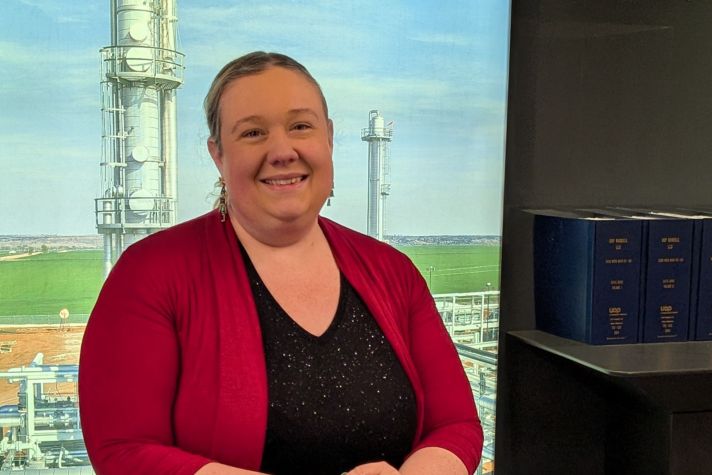Top Innovations of 2022
Get inspired by the inventions and upgrades that are enabling efficiency and promoting safety in buildings, air travel, industrial operations and beyond.
Breakthroughs from #Futureshapers have resulted in technologies that are allowing for healthier and more sustainable buildings; increased safety for pilots and drivers; and advancements in space exploration.
From new applications for low-global warming potential (GWP) molecules, to software that helps simplify the management of critical infrastructure, here’s a glimpse into some of this year’s top innovations:
Scaling sustainable aviation fuel (SAF) production
What it is: Technology that can convert ethanol into a renewable jet fuel that is energy-dense, stable and a drop-in fuel replacement with existing fueling infrastructure at airports.
Why it’s innovative: As demand for SAF increases, there’s a need for more non-fossil-derived feedstocks – in addition to fats, oils and greases – that can be converted into aviation fuel. Ethanol is widely abundant – you may be familiar with it from filling your car at the pump, as it’s in gasoline blended today in the United States.
Plus, with innovations like electric vehicles, the demand for gasoline could decrease in the future. Honeywell’s ethanol to jet technology is designed to help by using potentially excess ethanol for the purpose of conversion into sustainable aviation fuel.
Advancements in managing emissions
What it is: A software solution that uses sensor technology to measure greenhouse gas emission leaks; performs complex calculations to determine accurate greenhouse gas emissions across your enterprise; and can generate compliance reports with the click of a button.
Why it’s innovative: Manually collecting emissions data for a large company takes time, and managing the data with spreadsheets can be tedious and error-prone. Today’s sustainability-focused organizations need a solution to simplify the way they measure, monitor, reduce and report their greenhouse gas emissions, which is made possible with Honeywell Forge’s emissions management solution.
Tools enabling data center optimization
What it is: A set of software solutions known as Honeywell’s Data Center Suite, which allows data center managers and owners to optimize uptime, worker productivity, critical asset health and operational expenses – while providing better visibility into sustainability data.
Why it’s innovative: Data centers play a critical role in many essential parts of life and communities today – whether it’s dispatching emergency services or conveniences like the ability to access telehealth services or work remotely.
As the world relies more on data centers, it’s important for organizations to take steps to avoid preventable outages. Over the last three years, 40% of organizations experienced major data center outages caused by human error, according to the Uptime Institute. With Honeywell’s data center solutions, users get access to tools designed to help them improve centers’ overall efficiency and automate processes that are often ignored or conducted manually.
Expanded access to contactless payment
What it is: Software for Honeywell mobile computers that allows associates in retail, parcel delivery, public transportation and other industries to complete payments on the spot.
Why it’s innovative: As a shopper, you expect convenience. That’s where contactless payment comes in – by allowing retailers to meet you where you are and provide an additional, mobile checkout location. Since it’s compatible with commercial devices and major credit card brands, Honeywell’s Smart Pay software can also help retailers and other organizations eliminate the added costs of traditional accessories that mount on a mobile computer.
Technology increasing safety for pilots and drivers
What it is: A wearable headset that uses sensor and camera data to give aircraft pilots and drivers of ground vehicles situational awareness when they’re navigating in low-visibility conditions.
Why it’s innovative: Known as the Honeywell 360 Display, the headset uses data from sensors and cameras to give pilots and drivers a fuller view of their surroundings.
For pilots of passenger aircraft, the wearable visor uses augmented reality to provide a high-resolution, 360-degree view that matches the view outside the cockpit. While wearing the visor, pilots can also receive traffic callouts and flight instrumentation in their field of view – which can help when flying at night, in bad weather or in congested airspace. Through cameras and sensors, as a driver, you can see in every direction through the vehicle, even if its windows are not transparent.
Sustainable solutions for building operators and owners
What it is: The Honeywell Sustainable Buildings Manager – powered by Honeywell Forge – is a suite of solutions that is available now to help building owners and operators reduce buildings’ environmental impact and meet their carbon reduction goals, while optimizing indoor air quality.
Why it’s innovative: Buildings were responsible for 37% of global energy- and process-related CO2 emissions and 34% of energy demand globally in 2021, according to the United Nations Environment Programme in its 2022 Global Status Report for Buildings and Construction. This technology represents a breakthrough for building operators and owners, as they no longer have to choose between energy efficiency and occupant well-being. Plus, companies can fully account for their carbon emissions down to a device level using the energy-management-as-a-service offering Carbon & Energy Management application.
Images from the world’s most powerful space telescope
Photo: NASA/Chris Gunn
What it is: Launched into space in December 2021, the James Webb Space Telescope is an international program led by NASA with its partners the European Space Agency and the Canadian Space Agency. Each instrument on Webb plays an important role in allowing it to capture images that are helping scientists observe deep into the universe’s past.
Honeywell’s engineers built and tested the two-part instrument, the Fine Guidance Sensor and Near Infrared Imager and Slitless Spectrograph (FGS/NIRISS), that the Canadian Space Agency contributed to Webb.
The Fine Guidance Sensor (FGS), helps guide the telescope and point it precisely so it can focus on an object of interest. The Near Infrared Imager and Slitless Spectrograph (NIRISS) is designed to help scientists observe distant galaxies, as well as study the chemical composition of exoplanets’ atmospheres to possibly search for conditions that may be favorable for life.
Why it’s innovative: NASA released the Webb Telescope’s first full-color images in July, including the most-detailed infrared image of the early universe to date, among other findings revealing previously unseen details about galaxies and star births. Webb allows scientists to see deeper into the universe than its predecessor telescope, Hubble, which means scientists can obtain a fuller picture at the universe's evolution than previously possible.
Software simplifying warehouse operations
What it is: An industrial-grade software-powered solution that helps warehouse and distribution center managers and operators tackle unplanned downtime and automate data collection, as well as obtain visibility into the health of their warehouse assets in real-time.
Why it’s innovative: All eyes are on warehouses and distribution centers – whether it means keeping shelves at grocery stores stocked or getting e-commerce purchases to your doorstep faster. By detecting data from warehouse equipment, Honeywell Forge Connected Warehouse software makes recommendations through machine learning and artificial intelligence that can help inform warehouse operators' next move, whether it’s dispatching a maintenance worker to a problem area or getting boxes where they need to be.
Enabling a more sustainable future for respiratory care
What it is: Solstice® Air, part of Honeywell’s ultra-low global warming potential (GWP) line of products, is a non-flammable aerosol propellant in clinical development today for pressurized metered-dose inhalers (pMDIs). The Solstice® portfolio of hydrofluoroolefin (HFO) technology includes refrigerants for supermarkets, air conditioning for cars and trucks, blowing agents for insulation, propellants for personal and household care, and solvents for cleaning solutions.
Honeywell and AstraZeneca are teaming up to implement Solstice® Air propellant in respiratory inhalers for patients with asthma and chronic obstructive pulmonary disease (COPD) in an effort to help the pharmaceutical company reduce the environmental impact of respiratory care.
Why it’s innovative: The use of Solstice Air® propellant in next-generation respiratory inhalers — specifically pressurized metered-dose inhalers (pMDIs) — is impactful because a large percentage of people with asthma and COPD are prescribed medicine in pMDIs, and currently available inhalers use propellants in the form of hydrofluorocarbons (HFCs), which have a high global warming potential.
Increasing safety for electric vehicles
What it is: Announced as a strategic collaboration between Honeywell and Nexceris, the two companies will co-develop sensor-based gas detection solutions for electric vehicle (EV) battery packs, designed to help improve safety in EVs.
Why it’s innovative: You’re bound to start seeing more EVs on the road – maybe you’ve opted to go electric yourself. Global sales of EVs in 2021 reached $7 million, which is double 2020 sales, according to the International Energy Association. Enhancing EV battery safety is critical for not only EV drivers but also those who make and transport EVs and others on the road. While rare, batteries made for EVs can catch on fire if there are internal defects, an external short circuit or if the batteries are over-charged.
By collaborating with global vehicle manufacturers to deliver advanced gas detection solutions for EV battery packs, Honeywell and Nexceris aim to enable early intervention in the event of a safety concern.
Want to learn more? Meet some of the people behind Honeywell technologies that are enabling a safer and more sustainable world.





